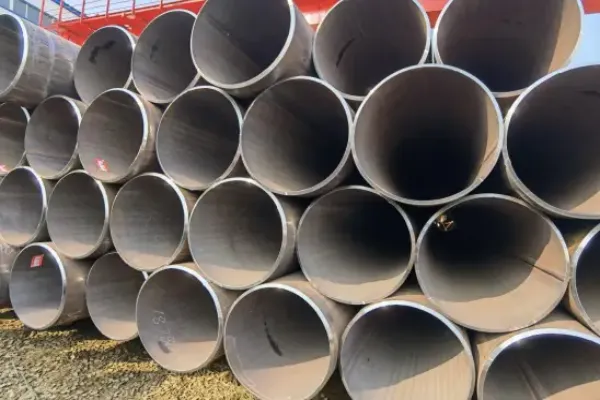The straight seam submerged arc welded steel pipes (LSAW Pipe) for oil pipeline engineering are generally manufactured by UOE and JCOE. The conventional production process is that after the steel pipe blank is formed by UO or JCO, it is pre-welded, internal and external final welded, expanded, non-destructive tested, pipe end processed, hydraulic pressure tested, weighed and measured, and visually inspected for steel pipe markings. Let's learn about the characteristics of the two processes of UOE and JCOE today!
Definition of UOE (U-O-Expanding)
The UOE forming process first requires beveling, flattening and bending the edges of the steel plate, then pressing it into a U shape through a forming machine, then bending it into an O shape. After the steel pipe is joined, it is pre-welded by gas shielded welding, then internal and external final welding is performed by submerged arc welding, and finally the whole pipe body is cold expanded by a segmented mechanical expansion process. After the steel pipe forming and welding is completed, a series of inspections are carried out. This process is currently the most widely used, most mature and most recognized large-diameter straight seam submerged arc welded pipe production process in the world.
The main features of UOE welded steel pipes:
1) The forming process is separated from the welding process, which is a non-continuous single-piece production.
2) Thick-walled steel pipes can be produced, with a maximum wall thickness of about 40mm.
3) The weld length of the steel pipe is only half of the spiral weld length at the same length, and the probability of weld defects is low.
4) High output, the output of a UOE unit is generally equivalent to the total output of 2 to 4 spiral welded pipe units.
5) The expansion process is used to improve the strength and dimensional accuracy of the steel pipe.
6) UOE steel pipes are straight seams, which makes pipeline laying and maintenance more convenient.
7) The equipment is larger than the spiral welded pipe unit, and the investment cost is high.
Specifications of UOE LSAW Pipe
|
UOE LSAW Pipe
|
|
Outside Diameter:Φ508mm - 1118mm (20"- 44")
|
|
Wall Thickness: 6.0 - 25.4mm 1/4"-1"
|
|
Quality Standards: API、DNV、ISO、DEP、EN、ASTM、DIN、BS、JIS、GB、CSA
|
|
Length: 9 - 12.3m (30'- 40')
|
|
Grades: API 5L A-X90, GB/T9711 L190-L625
|
What is JCOE (J-C-O-Expanding)?
Compared with the UOE forming method, the JCOE forming process has relatively low cost, strong process adaptability, less wear on the forming mold, and light forming mold. Its process and products are widely used. The JCOE pipe making process is to form the steel plate in the order of J forming - C forming - O forming, and then use gas shielded welding for pre-welding after the steel pipe is joined, and then use submerged arc welding for internal and external final welding, and finally use the segmented mechanical expansion process to cold expand the entire pipe body, and finally a series of inspections are carried out.
Specifications of JCOE LSAW Pipe
|
JCOE LSAW Pipe
|
|
Outside Diameter:Φ406mm - 1626mm (16" - 64" )
|
|
Wall Thickness:6.0 - 75mm (1/4" - 3" )
|
|
Quality Standards:API、DNV、ISO、DEP、EN、ASTM、DIN、BS、JIS、GB、CSA
|
|
Length:3 - 12.5m ( 10'- 41' )
|
|
Grades:API 5L A-X100, GB/T9711 L190-L690
|
The main features of the JCOE process:
1) Each forming process of JCOE is completed on a large press, the steel pipe shaping operation requires high technical requirements, and the forming unit occupies a long time. Due to multiple forming, the processing efficiency is low compared to the UOE process, but there are fewer molds and lower equipment investment. Therefore, the number of JCOE units in China is more than that of UOE units.
2) Since JCOE is a multi-step pressing, the dimensional accuracy of the steel pipe is lower than that of UOE, so UOE steel pipes are mostly used in marine pipelines.
UOE vs JCOE: Key Differences
JCOE forming process and UOE forming process are two main forming methods used to manufacture straight seam submerged arc welded steel pipe (LSAW pipe). They have obvious differences in forming method, equipment structure, application scope, production efficiency and cost investment:
|
Feature
|
UOE
|
JCOE
|
|
Forming Style
|
Simultaneous U-O pressing
|
Gradual J-C-O pressing
|
|
Pipe Roundness
|
High
|
Moderate
|
|
Production Scale
|
Large batch
|
Small to medium batch
|
|
Investment Cost
|
High
|
Moderate
|
|
Wall Thickness Capacity
|
Thick and uniform
|
Medium to thick
|
|
Application Focus
|
Offshore & high-pressure pipelines
|
Onshore, piling pipe & structural use
|
|
|
|
|
The biggest difference between JCOE and UOE forming processes lies in the forming method. The UOE process is formed in one step through three steps of U-shaped, O-shaped pressing and diameter expansion, with high forming accuracy, which is suitable for large-diameter thick-walled steel pipes. The JCOE process is a segmented pressing, from J-shaped to C-shaped and then to O-shaped, gradually completing the circular structure, with stronger adaptability and suitable for small-batch production of multiple specifications.
In addition, the two are also different in equipment and cost. UOE equipment has a large investment and a high degree of automation, which is suitable for continuous and large-scale production; JCOE equipment is relatively simple, with low initial investment, and is suitable for small and medium-sized enterprises.
Finally, UOE steel pipes have better dimensional accuracy and weld consistency, which is suitable for high-demand projects; JCOE forming is flexible, cost-effective, and meets diverse market needs.






 English
English Español
Español بالعربية
بالعربية











 Phone :
Phone :  Whatsapp :
Whatsapp :  Email :
Email : 


